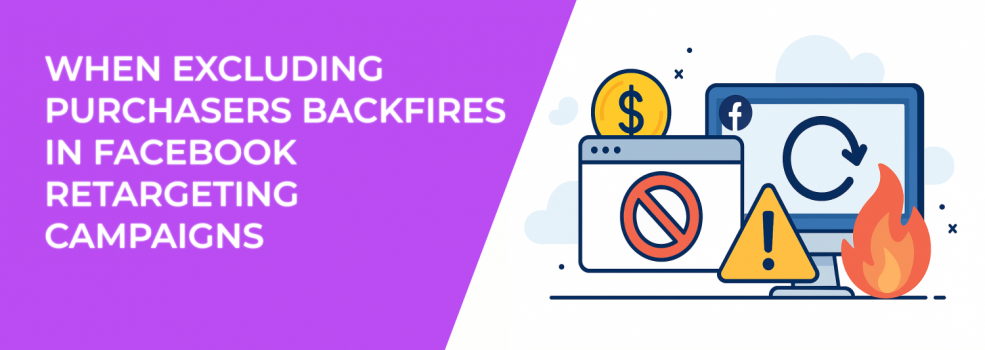Ever launched a Facebook retargeting campaign that should’ve worked but didn’t?
If you’re excluding everyone who already bought from you, thinking it’s the “smart” move, you might be blocking your best buyers from ever seeing your ads again.
Yes, that sounds strange. But it’s a common trap.
Let’s take a deeper look at why excluding purchasers in Facebook retargeting campaigns often does more harm than good — and what to do instead.
Why Advertisers Exclude Purchasers in the First Place
Most advertisers set up exclusions as a way to improve targeting and preserve their budgets. On paper, it makes perfect sense. If someone has already completed your main conversion action — like buying a product, signing up for a service, or subscribing to a plan — why would you keep spending money to show them more ads?
Here’s the typical reasoning:
-
They assume past buyers don’t need to see more ads. These users have already taken the desired action, so continuing to advertise to them feels redundant.
-
They want to save budget. Excluding purchasers seems like a logical way to focus ad spend only on new leads or unconverted traffic.
-
They believe exclusion keeps the message relevant. Why advertise a product to someone who already has it?
This approach is taught in many beginner-level Facebook Ads courses, so it's widely adopted without much questioning. But over time, this default exclusion tactic can lead to missed revenue, weakened campaign performance, and a slower algorithm learning process.
To better understand when exclusions help versus hurt, read When to Use Exclude Targeting on Facebook and Why It Matters.
The Hidden Value of Purchasers in Retargeting
Not all purchasers are equal — and that’s a crucial insight for marketers. Excluding everyone who ever made a purchase might seem clean and efficient, but it erases valuable nuance in buyer behavior.
Think about your own habits. Have you ever bought something small from a brand, then returned to purchase something bigger or more expensive? Or maybe you got an email, saw an ad, and made a repeat purchase because the timing was right?
The same applies to your customers.
When you exclude them, here’s what you miss:
-
Opportunities for upsells. Someone who bought a basic product may now be ready to upgrade to a premium version.
-
Add-on purchases. Complementary products — like accessories, bundles, or tools — are often logical next steps for recent buyers.
-
Loyalty-driven repeat buys. Customers with a positive experience are primed to come back, especially if they see your brand again within days or weeks.
-
Subscription upgrades. If your product offers monthly or yearly options, existing users can be nudged to switch tiers or renew earlier.
-
Seasonal or time-sensitive campaigns. Past buyers are excellent targets for Black Friday, holiday bundles, or limited-edition drops.
For a tactical breakdown of how to activate these opportunities, check out Facebook Ads for E-Commerce: How to Drive Sales Through Retargeting.
Facebook’s Algorithm Needs Data — Don’t Starve It
One often overlooked aspect of audience exclusions is how they impact Facebook’s optimization engine.
The algorithm behind Facebook Ads needs data to perform well. It works best with large pools of users, steady feedback loops, and consistent conversion events. When you over-exclude — especially high-intent audiences like recent buyers — you make the platform's job harder.
Here’s what can happen when exclusions go too far:
-
Smaller custom audiences. Your retargeting pool becomes too narrow to deliver impressions effectively.
-
Longer learning phases. Facebook needs more time to gather signals and stabilize delivery.
-
Higher CPMs (cost per 1,000 impressions). With a limited audience, competition and cost go up.
-
Weaker optimization. Facebook has fewer successful actions to model from, reducing its ability to target well.
Worse still, you might unintentionally overlap exclusions. For example, you exclude website visitors AND recent purchasers, and then you use lookalike audiences based on those same sources. The result? You're sabotaging your own reach.
To avoid this, read The Role of Audience Overlap in Facebook Ads Performance.
What Should You Do Instead? Smarter Segmentation
Instead of removing purchasers entirely, you can refine your strategy with segmentation. This gives you more control over who sees what and when — and allows you to speak to different customer segments with tailored creative.
Here are five smart ways to retarget purchasers more effectively:
-
Exclude only recent purchasers. Rather than blocking all-time buyers, exclude users from the last 7 to 14 days. These people are unlikely to buy again immediately, but may be ready in 30 days.
-
Segment by product or category. If someone bought from one product category, you can show them related but different categories. Cross-selling works exceptionally well this way.
-
Target by purchase value. High-value buyers often have different expectations and LTV (lifetime value). Segment them out and test higher-end offers or exclusive bundles.
-
Build cross-sell audiences. Use custom audiences to reach customers who bought product A, and show them ads for product B.
-
Test different time windows. Create segments based on 30-day, 60-day, and 90-day purchase windows to see which groups respond best to re-engagement campaigns.
For more on segmentation frameworks, read Custom vs Lookalike Audiences: What Works Best for Facebook Campaigns.
Retargeting Isn’t Just About Conversions
Sometimes the goal of retargeting isn’t just another purchase. It’s building trust, strengthening customer relationships, and increasing the lifetime value of your audience.
You can use retargeting to:
-
Educate. Share onboarding content, product tutorials, or feature highlights.
-
Build community. Promote your Facebook Group, newsletter, or events.
-
Offer perks. Reward past buyers with VIP offers, loyalty discounts, or early access.
-
Re-engage. Target lapsed customers (60-90+ days) with reminders or feedback surveys.
-
Introduce new products. Showcase your latest launch to people who already know and trust your brand.
If your audience is small and you think retargeting isn't viable, check How to Optimize Audience Targeting for Facebook Ads with Limited Data for practical workarounds.
Final Thoughts
You don’t need to abandon exclusions entirely. But you do need to be intentional about them. Broad, blanket exclusions might feel efficient, but they often eliminate your most profitable and loyal customers.
Instead, build smarter segments, test different windows, and keep your messaging relevant. Let Facebook’s algorithm optimize with full access to valuable data — not just new leads.
Rethinking your exclusions can open the door to more upsells, deeper brand relationships, and better long-term ROI.

